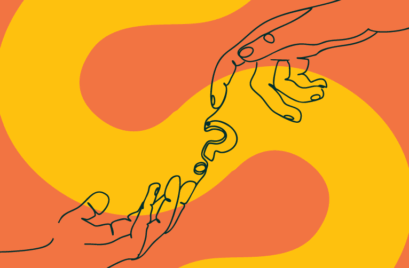
“The first pillar of joy… the first pillar of truth… and the first pillar of justice… is perspective.” The Book of Joy by Dalai Lama and Desmond Tutu
A flutter of excitement in your chest. Warmth trickling into your stomach. A lightness of being. An openhearted, expansive moment of exultation…any of these visceral reactions might be your experience of joy. The way it manifests for you is likely to be energising, but also fleeting – only a few ephemeral moments in time. So, how do we get more of it in our lives? And is it the same as being happy?
Joy versus Happiness
The way joy and happiness show up in our lives is the subject of much research and many opinions, with the two concepts often being seen as interchangeable descriptions of the same feeling. What we are beginning to understand from new research though, is that joy is both a state and a trait. It can be either a fleeting emotional experience, or an intrinsic characteristic of our personality.
Of the many definitions of joy, here are two that resonate with us:
This sense of the just right fit is an intriguing one. Whether it’s having a win at work, in sport, in school, or simply appreciating the bright energy of a spring day – joy is accompanied by some kind of alignment between our core being and the moment. Creating the opportunity for this alignment to occur more often, is what we might call building an emotional culture of joy. And this has many benefits, especially in the workplace.
For instance, we now know that an emotional culture of joy significantly predicts happiness at work. Furthermore, an emotional culture of joy significantly and positively influences both psychological safety and relational attachment.
In other words, the degree of psychological safety we experience and the relational attachment we feel toward others, at work, increases when we have an emotional culture of joy, and this will have a significant impact on how happy we are to be there.
Knowing your Joy
The initial step in inviting more joy into your life is to get curious about what makes you joyful. Start by asking yourself:
- What kinds of experiences do you consider to be joyful?
- Do your joyful experiences have a common theme?
- What proportion of your joyful experiences are social, involving the presence of loved and trusted others?
- What types of joy can you experience alone?
- Under what conditions does working inspire feelings of joy for you?
- What could you do to make work more joyful for you?
It’s worth mentioning here that our experience of joy doesn’t automatically come with an ethical evaluation. We can also experience it in less generous ways, such as explained by the concept of schadenfreude – which is the joy experienced from perceiving another person’s misfortune (*Conversely, there is also gluckschmerz – feeling pain from another’s good fortune.) Our ability to feel joy for the “wrong” reasons means that it is important to first check our sources of joy and evaluate them. It might be that we could also benefit from shifting our mindset.
Building an Emotional Culture of Joy
Once we have clarity on what brings us joy, we can begin building a culture that supports it, and its accompanying happiness. But what is an emotional culture?
Emotional culture refers to “the behavioral norms and artifacts, as well as the underlying values and assumptions, that guide the expression (or suppression) of specific emotions and the appropriateness of displaying those emotions within a social unit.”
In a work context, this might translate through our organisational values, leadership modelling, embedded practices of recognition and celebration, whole team feedback loops, and attention to psychological safety.
Think about it. Is there an explicit understanding in your workplace that it’s okay to express joy? How are you encouraging it? Can it be noisy? Is it allowed to take up time? If not, then here are a few starter suggestions that will set up the right environment, while enhancing productivity:
- Model joyful behaviours through your VIBE, i.e., not just what you say, but your entire body language – encourage yourself and your team to get easily excited and enthusiastic
- Connect positive emotions to operational tasks and goals, i.e., use reward and celebration with deep and uninhibited intent
- Stay attentive and connected to your feedback loops, e.g., humanise and personalise your communication, so that team members feel seen, heard, and valued
- Respect emotions; give them space. Professionalism does not equate to the suppression of feelings. Nurture avenues for positive self-expression and exuberance, e.g., dance offs, wellness challenges
- Share your ikigai – your purpose and passion for living – and spread the contagion
And here are some fun ways to bring joy and excitement into the workplace:
- Organise an inflatable costume race
- Enjoy work karaoke on lunch break
- Flash mobs never go out of style
- Bring a board game to work day
- Decorate the office – regularly
- Pay a compliment, or appreciate someone out loud
- Plan a positive surprise
- Create a “fun” social contract
- Allow work time for volunteering
Learning to engage more fully with joy, will invigorate and enrich all aspects of work life, and prolong those moments of experiencing the perfect fit.







